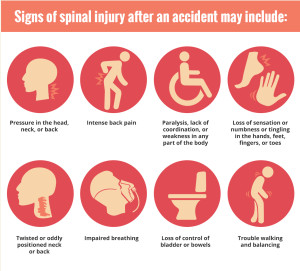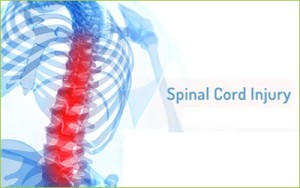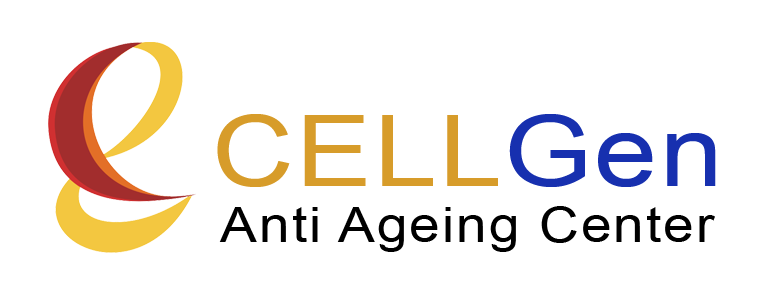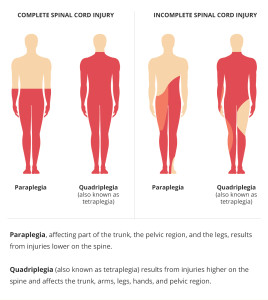Spinal cord injuries affect people of all ages. Being so debilitating by nature, these injuries cause not only physical and mental pain but also emotional stress as well. Although there are support groups and other coping mechanisms exist, the fact of not being able to cure such injuries often cause a feeling of helplessness and trauma to patients and their families.
To understand better, a spinal cord injury involves damage to any part of the spinal cord or nerves at attached to the spinal canal to often causes permanent changes in strength, sensation and other body functions below the site of the injury.
Limb control after a spinal cord injury depends upon two factors:
- Place of the injury on the spinal cord
- Severity of injury to the spinal cord
The lowest part of the spinal cord to function normally after injury is referred to as the neurological level of the injury. The severity of the injury is classified as:
- If almost all feeling (sensory) and all ability to control movement (motor function) is lost below the spinal cord injury.
- If there is some motor or sensory function below the affected area.
There are varying degrees of incomplete injury.
Paralysis from a spinal cord injury can also be called:
- Also known as quadriplegia implying that the arms, hands, trunk, legs and pelvic organs are all affected by the spinal cord injury.
- This paralysis affects all or part of the trunk, legs and pelvic organs.
Diagnostic tests and other neurological examinations are performed to determine the type and extent of injury by certified medical personnel.
Signs and Symptoms of a Spinal Cord Injury
- Loss of movement

- Loss of sensation, including the ability to feel touch or temperature
- Loss of bowel or bladder control
- Exaggerated reflex activities or spasms
- Changes in sexual function, sexual sensitivity and fertility
- Pain or an intense stinging sensation caused by damage to the nerve fibers in the spinal cord
- Difficulty breathing, coughing or clearing secretions from lungs
Common causes of spinal cord injury
The most common causes of spinal cord injuries are:
- Motor vehicle accidents – Auto and motorcycle accidents are the leading cause of spinal cord injuries.
- Falls – Spinal cord injury after age 65 is most often caused by a fall. Overall, falls cause more than one-quarter of spinal cord injuries.
- Acts of violence – Resulting from violent encounters, often involving gunshot and knife wounds.
- Sports and recreation injuries – Athletic activities, such as impact sports and diving in shallow water.
- Alcohol – Alcohol use is a factor in about 1 out of every 4 spinal cord injuries.
- Diseases – Cancer, arthritis, osteoporosis and inflammation of the spinal cord also can cause spinal cord injuries.
Presently, post-accident care for spinal cord injury patients focuses on extensive physical therapy, occupational therapy, and other rehabilitation therapies; teaching the injured person how to cope with their disability and providing emotional support for them and their families through various support groups and other social activities.
Stem Cells could be the Key; we’ve all been looking for.
Stem cells are known to be the building blocks of life and thus extensive research has and is been carried out to harness the potential of these cells to protect healthy cells, repair damaged cells and regenerate new cells to keep up bodily function.
The potential of stem cells or progenitor cells to support spinal cord repair has been studied substantially and there is little doubt that stem cells and neural progenitor cells can be considered to be invaluable components of repair strategies for the spinal cord.
is little doubt that stem cells and neural progenitor cells can be considered to be invaluable components of repair strategies for the spinal cord.
Stem cells can be directed to differentiate into neural cells which can be used for replacement of neural cells lost after spinal cord injury. They can become neural cells that may support anatomical and functional recovery. Alternatively, they may secrete growth factors that could support neuroprotection and maybe axon regeneration as well.
The neuroprotective property can limit secondary tissue loss and prohibit further loss of function. Axon promoting properties of stem cells could restore damaged axon circuits and promote the growth of new circuits. Functional recovery could be achieved due axon regeneration and growth promoting factor.
Another positive aspect of this therapy involves healing characteristics of stem cells that include its anti-inflammatory activity and immune modulating capacity to stimulate regeneration wherever required.
Mesenchymal stem cells do not need to be HLA matched as there is no threat of cell rejection as stem cells are immune system privileged. Allogenic stem cells can also be administered in high cell counts or as a part of therapeutic procedure of stem cell treatment.
Stem cells can help those who suffer from spinal cord injuries or neural degeneration.


Recent Comments